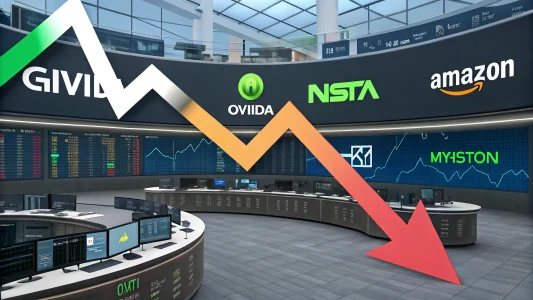This week is packed with events that could significantly impact markets and shape the trajectory of the economy. The focus is simple. Three market movers are on deck: a potential government shutdown, the JOLTS job openings report, and the September jobs report. Together, they can shift expectations for growth, inflation, and interest rates. With stocks at or near record levels, the stakes feel high.
“Investors, three market movers to watch this week.”
Table of Contents
ToggleThe Shutdown Threat: Why It Matters for Markets
Congress faces a deadline. If lawmakers do not agree on a budget by midnight Wednesday, the federal government could shut down. That alone can cause market jitters. The bigger concern is the knock-on effect — the potential delay of major economic data and the chill that can hit consumer and business confidence.
The worry is not only fewer workers on the job. Talk of widespread firings would add another layer of uncertainty. That kind of language can freeze hiring plans, slow spending, and raise cash hoarding across companies. Markets do not like unknowns. A shutdown adds exactly that, and it ripples through risk appetite.
Another practical issue: data. If the Bureau of Labor Statistics (BLS) cannot operate as usual, it may not release one of the most-watched reports of the year — the September jobs report. When data goes dark, investors fly blind. That can lift volatility as traders guess at growth and inflation without an agreed set of numbers.
“If the government shuts down, the BLS is not going to release these numbers.”
It might feel odd that one report can hold so much sway. But in a world where interest rates hinge on the balance of job growth, wage gains, and inflation, it matters a lot. If we lose the September jobs report, the market will rely on second-tier data, private surveys, and company commentary, all of which can be noisy and uneven.
View this post on Instagram
Why the JOLTS Report Still Moves the Needle
On Tuesday, we get the Job Openings and Labor Turnover Survey (JOLTS). It shows the number of unfilled positions, along with hires and quits. These figures help us see how tight the labor market is. Post-COVID, job openings soared. Since then, they’ve been falling fast. That downtrend is one of the clearest signs that the labor market is cooling.
If openings keep dropping, it usually points to slower wage growth ahead. That can help ease inflation. It also supports a case for the Federal Reserve to pause or even cut rates sooner than expected. On the flip side, if openings stabilize or rebound, it signals lingering tightness. That raises the odds of sticky inflation and a more cautious Fed.
Keep an eye on the quits rate. When people voluntarily leave jobs, it often means they feel confident they can find a better one. A falling quits rate shows confidence is fading. That tends to ease wage pressure and slow consumption, which affect earnings and stock prices.
The September Jobs Report: The Big One
Friday’s job report is the heavyweight on the calendar. It shows how many nonfarm payroll jobs were added, along with the unemployment rate, labor force participation, and wage growth. If it comes out on time, markets will read every line.
Here’s the context. Job gains surged during the post-COVID recovery, often running at eye-popping levels. Recently, growth has throttled back sharply.
“We went from 400 to 800,000 jobs added per month post COVID to less than twenty seven thousand added over the past four months.”
If Friday confirms that slowdown, the conversation shifts. Investors will weigh the tradeoff between softer growth and lower inflation. Slower job creation can help the inflation fight, but it also challenges revenue and profit forecasts. If the report shows a rebound, it supports stronger earnings but risks keeping inflation sticky. That could mean interest rates stay higher for longer. Either way, this report is a pivot point.
What I’m watching in the details:
- Headline payrolls: The broad measure of jobs added. A soft print bolsters the case for easier policy next year.
- Unemployment rate: A rise often points to cooling demand for labor, especially if participation is steady.
- Average hourly earnings: Wage growth feeds into inflation. Slower pay gains ease price pressure.
- Labor force participation: If more people return to work, it can help ease wage growth without hurting output.
Stocks Near Highs: Why This Week Feels Tense
Equities have climbed back to lofty levels. When prices are high, expectations are high. That can make the market more sensitive to surprises. A weak report can knock momentum. A hot report can lift rates and pressure valuations. In both scenarios, swings can be sharp.
This is where time horizon matters. Long-term investors should keep a steady plan. Short-term traders need to manage risk. In my experience, the worst decisions come from chasing each headline. Instead, I track the trend. Is the labor market cooling at a controlled pace, or are we tipping into a stall?
Scenarios I’m Preparing For
Here’s how I think about the week’s possible paths, and how each could shape market tone in the near term.
Scenario 1: Shutdown and no jobs report. Expect higher volatility as investors lose a key data point. Stocks may wobble as rates bounce around. Defensive sectors could find support. Cash-rich balance sheets and stable dividends gain appeal. In this setup, patience beats prediction.
Scenario 2: Shutdown avoided, soft labor data. If JOLTS and the jobs report both show further cooling, long-term yields could ease. Rate-sensitive areas like homebuilders and utilities might catch a bid. Tech can benefit if discount rates slip. But high-multiple names still need earnings to back them up.
Scenario 3: Shutdown avoided, strong labor data. A rebound in openings and payrolls signals resilience. That supports earnings but may push yields up again. Financials can benefit from a steeper curve. Cyclicals tied to growth may lead. The trade-off is valuation pressure on the most expensive stocks.
A Simple Playbook for Investors
My advice is to keep a clear plan and avoid whipsaw. Here’s a simple checklist I use around weeks like this.
- Know your time horizon: Daily noise matters less if you’re a long-term investor.
- Review your allocations: Are you overexposed to a single sector or theme?
- Hold quality: Strong cash flow, reasonable debt, and consistent earnings travel well through cycles.
- Use volatility wisely: Rebalance toward targets rather than reacting to every swing.
- Watch the bond market: Moves in yields often lead stock rotations.
What I’m Watching Day by Day
Tuesday: JOLTS. I’ll focus first on the total number of openings, then the quits rate. If openings fall again and quits stay low, it reinforces a cooling labor market. That’s helpful for the inflation fight. It also supports the idea that the Fed can take its foot off the brake in coming months.
Midweek: Shutdown decision. I’ll be watching for any sign of a short-term funding measure. Even a brief extension can calm markets. If talks break down, the new question becomes how long the disruption lasts and which agencies are affected. For markets, time is the key variable.
Friday: Jobs report. If the report is released, the trio of headline payrolls, wage growth, and unemployment will set the tone. A balanced print — modest job growth, cooler wages, steady unemployment — would be market-friendly. It points to a softer landing. A hot number raises rate concerns. A very weak number stirs growth fears.
How a Cooling Labor Market Shows Up in Portfolios
A slowing jobs market tends to show up in several ways:
- Lower wage pressure can ease inflation, which often helps bonds and rate-sensitive stocks.
- Consumers may tighten spending, affecting retail, travel, and discretionary goods.
- Companies may slow hiring or delay projects, which can hit small caps harder than large caps.
- Stable cash generators and defensive sectors can gain relative strength.
None of this is automatic. The market often prices in moves ahead of the data. That’s why I keep a disciplined process. I avoid swinging the portfolio on every headline. Instead, I adjust at the edges when the data shows a clear trend.
Reading the Tea Leaves Without the Jobs Report
If the shutdown blocks the BLS release, I’ll shift to other signals. Weekly jobless claims, private payroll estimates, corporate hiring commentary, and credit card spending data can help fill the gap. They are noisier, but they point in the same direction over time.
I’ll also watch credit markets. When credit spreads widen, it often signals rising concern about growth. If spreads stay contained, it suggests investors still expect a soft landing. Treasury yields tell part of the story as well. A drop in long yields after soft labor signals can support equity valuations, but only if earnings hold up.
What This Week Could Mean for the Fed
Policy makers watch the same numbers we do. If JOLTS shows fewer openings and the jobs report confirms slower hiring and wage growth, the case for rate cuts next year strengthens. If the data runs hot, cuts can be pushed out. Either path can be workable for investors. The key is to align your holdings with your goals and risk level, not with your guess of the next data point.
My approach is steady. I trim strength in crowded trades and add to areas where the risk-reward looks favorable. I value resilience more than perfect timing.
Bottom Line
This week’s trio — shutdown risk, JOLTS, and the September jobs report — could shape views on growth, inflation, and rates. With stocks near highs, swings can be sharp. A shutdown would remove key data and raise uncertainty. A JOLTS downtrend points to a cooling labor market. The jobs report, if released, will either confirm the slowdown or hint at a rebound.
“The question, does this week confirm the economic slowdown or show signs of a rebound?”
My recommendation is simple. Stay disciplined. Keep quality at the core. Use volatility to rebalance. Let the data guide your pace, not your principles. Markets reward patience and preparation more than bold calls on a single week’s headlines.

















